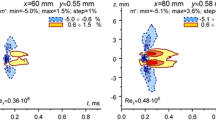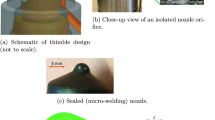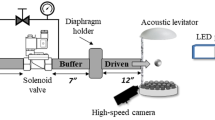A numerical investigation was carried out to study the influence of the shape of pulses (rectangular, triangular, and sinusoidal) on heat transfer at the stagnation point of an impact pulsed gas–droplet jet. It is shown that in a nonstationary two-phase impact jet both an increase and suppression of heat transfer are possible in comparison with stationary flow for all pulse shapes studied. In the region of small distances between the pipe cut and the barrier (up to four pipe diameters) in the pulsed gas–droplet jet, the heat transfer at the stagnation point increases, while at large distances (more than five pipe diameters), the heat transfer rate decreases in the pulsed flow. This is typical of all the pulse shapes studied in this work. An increase in the Reynolds number causes a decrease in heat transfer intensification, and the results of calculations for all types of signal shapes approach the stationary mode of a twophase impact jet.
Similar content being viewed by others
References
E. P. Dyban and A. I. Mazur, Convective Heat Transfer in Jet Flow around Bodies [in Russian], Naukova Dumka, Kiev (1982).
A. S. Mujumdar, Impingement drying, in: A. S. Mujumdar (Ed.), Handbook of Industrial Drying, 3rd edn., Taylor & Francis Group, New York (2007), pp. 385–395.
M. Garbero, M. Vanni, and U. Fritsching, Gas/surface heat transfer in spray deposition processes, Int. J. Heat Fluid Flow, 27, 105–122 (2006).
J. H. Kim, Spray cooling heat transfer: the state of the art, Int. J. Heat Fluid Flow, 28, 753–767 (2007).
G. Liang and I. Mudawar, Review of spray cooling — Part 1: Single-phase and nucleate boiling regimes, and critical heat flux, Int. J. Heat Mass Transf., 115, 1174–1205 (2017).
S. S. Makarov, A. M. Lipanov, and A. I. Karpov, Numerical investigation of heat transfer during the cooling of a metal cylinder by a flow of a gas–liquid medium in an air channel, J. Eng. Phys. Thermophys., 92, No. 4, 988–996 (2019).
Yu. A. Buyevich and V. N. Mankevich, Cooling of a superheated surface with a jet mist flow, Int. J. Heat Mass Transf., 39, 2353–2362 (1996).
X. Li, J. L. Gaddis, and T. Wang, Mist/steam heat transfer of confined slot jet impingement, ASME J. Turbomach., 123, 161–167 (2000).
M. A. Pakhomov and V. I. Terekhov, Enhancement of an impingement heat transfer between turbulent mist jet and flat surface, Int. J. Heat Mass Transf., 53, 3156–3165 (2010).
Z. Zhang, P.-X. Jiang, Y.-T. Hu, and J. Li, Experimental investigation of continual and intermittent-spray cooling, Exp. Heat Transf., 26, 453–469 (2013).
F. N. M. Elwekeel and A. M. M. Abdala, Eff ects of mist and jet cross-section on heat transfer for a confined air jet impinging on a flat plate, Int. J. Thermal Sci., 108, 174–184 (2016).
C. Khangembam, D. Singh, J. Handique, and K. Singh, Experimental and numerical study of air–water mist jet impingement cooling on a cylinder, Int. J. Heat Mass Transf., 150, Article ID 119368 (2020).
M. R. O. Panao and A. L. N. Moreira, Thermo- and fl uid dynamics characterization of spray cooling with pulsed sprays, Exp. Thermal Fluid Sci., 30, 79–96 (2005).
A. D. Nazarov, A. F. Serov, V. I. Terekhov, and K. A. Sharov, Experimental investigation of evaporative pulse-spray impingement cooling, J. Eng. Phys. Thermophys., 82, No. 6, 1184–1190 (2009).
A. D. Nazarov, A. F. Serov, and V. I. Terekhov, Structure of the pulsed sprayed jet with a change in its frequency characteristics, Teplofi z. Vys. Temp., 49, No. 1, 116–121 (2011).
M. A. Pakhomov and V. I. Terekhov, Structure of fl ow and turbulent heat and mass transfer at the frontal point of an impact pulsed gas–droplet jet, Teplofi z. Vys. Temp., 52, No. 4, 588–596 (2014).
M. A. Pakhomov and V. I. Terekhov, RANS modeling of fl ow structure and turbulent heat transfer in pulsed gas–droplet mist jet impingement, Int. J. Thermal Sci., 100, 284–297 (2016).
H. Herwig and G. Middelberg, The physics of unsteady jet impingement and its heat transfer performance, Acta Mechanica, 201, 171–184 (2008).
L. P. Geng, C. B. Zheng, and J. W. Zhou, Heat transfer characteristics of impinging jets: The infl uence of unsteadiness with different waveforms, Int. Commun. Heat Mass Transf., 66, 105–113 ( 2015).
M. A. Pakhomov and V. I. Terekhov, RANS simulation of the effect of pulses form on fluid flow and convective heat transfer in an intermittent round jet impingement, Energies, 13, Article ID 4025 (2020).
H. M. Hofmann, D. L. Movileanu, M. Kind, and H. Martin, Influence of a pulsation on heat transfer and flow structure in submerged impinging jets, Int. J. Heat Mass Transf., 50, 3638–3648 (2007).
S. Jahangiri, A. H. Shiravi, M. Hosseinalipour, and A. S. Mujumdar, Numerical study of the oscillation amplitude effect on the heat transfer of oscillatory impinging round jets, Numer. Heat Transf., Pt. B, 79, 70-82 (2021).
T. J. Craft and B. T. Launder, New wall-reflection model applied to the turbulent impinging jet, AIAA J., 30, 2970–2972 (1992).
V. I. Derevich and L. I. Zaichik, Settling of particles from a turbulent flow, Izv. Akad. Nauk SSSR, Mekh. Zhidk. Gaza, No. 5, 96–104 (1988).
M. W. Reeks, On a kinetic equation for the transport of particles in turbulent flows, Phys. Fluids A, 3, 446–456 (1991).
L. I. Zaichik, A statistical model of particle transport and heat transfer in turbulent shear flows, Phys. Fluids, 11, 1521–1534 (1999).
V. I. Derevich, Statistical modelling of mass transfer. 1. Model development, Int. J. Heat Mass Transf., 43, 3709–3724 (2000).
Author information
Authors and Affiliations
Corresponding author
Additional information
Translated from Inzhenerno-Fizicheskii Zhurnal, Vol. 95, No. 4, pp. 1000–1005, July–August, 2022.
Rights and permissions
Springer Nature or its licensor holds exclusive rights to this article under a publishing agreement with the author(s) or other rightsholder(s); author self-archiving of the accepted manuscript version of this article is solely governed by the terms of such publishing agreement and applicable law.
About this article
Cite this article
Pakhomov, M.A., Terekhov, V.I. Effect of the Shape of Pulses on Heat Transfer at the Stagnation Point of a Nonstationary Axisymmetric Impact Gas–Droplet Jet. J Eng Phys Thermophy 95, 985–990 (2022). https://doi.org/10.1007/s10891-022-02562-3
Received:
Published:
Issue Date:
DOI: https://doi.org/10.1007/s10891-022-02562-3




